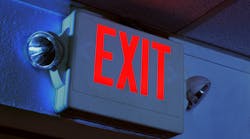When fire suppression systems automatically protect entire rooms, following Best Practices can mean the difference between tragedy and "just another exciting day." We listed some best practices you should follow in Part 2. Let’s take a look at three more practices you should make a part of your routine.
• Always inform your supervisor and the room’s supervising authority just before you enter the room and just as you exit the room.
• Upon entering the room, note the location of the exits. Mentally draw the path to get to the nearest one from where you will be working. Also note the location of safety equipment such as eyewash stations and emergency showers; issues (e.g., battery acid) related to the call for a room to be fire-suppressed often call for this equipment to be in the room.
• If a fire occurs in a fire-suppressed room, don’t attempt to extinguish it; the fire suppression system will handle that job. Your job is to leave the room immediately, and report the incident to your supervisor and the room’s supervising authority. Know ahead of time where you should physically go (e.g., the control room).



